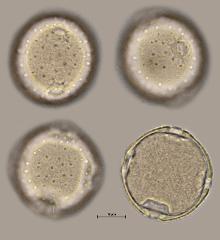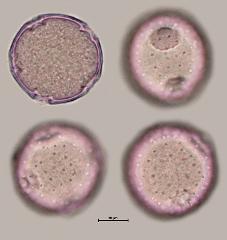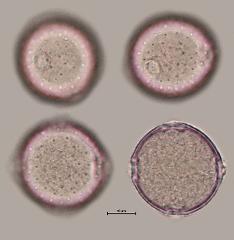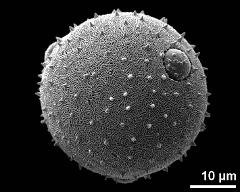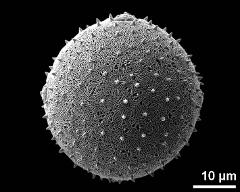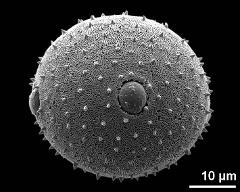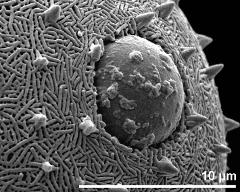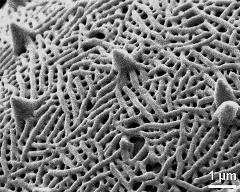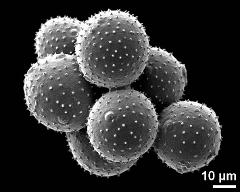Phyteuma hemisphaericum
Taxonomy: Angiospermae, Asterales, Campanulaceae, Phyteuma
Links: http://flora.nhm-wien.ac.at/Seiten-Arten/Phyteuma-hemisphaericum.htm
Published: 2020-12-21
Pollen Description
Shape, Size and Aperture
pollen unit: monad, dispersal unit and peculiarities: monad, size (pollen unit): medium-sized (26-50 µm), size of hydrated pollen (LM): 31-35 µm, shortest polar axis in equatorial view (LM): -, longest polar axis in equatorial view (LM): -, shortest diameter in equatorial or polar view (LM): 31-35 µm, longest diameter in equatorial or polar view (LM): 31-35 µm, pollen class: porate, polarity: isopolar, P/E-ratio: -, shape: spheroidal, outline in polar view: circular, dominant orientation (LM): oblique, P/E-ratio (dry pollen): -, shape (dry pollen): spheroidal, outline in polar view (dry pollen): circular, infoldings (dry pollen): not infolded, aperture number: 4, aperture type: porus, aperture condition: pantoporate, porate, triporate, tetraporate, aperture peculiarities: -
Ornamentation and Structure
LM ornamentation LM: echinate, nexine: -, sexine: -, SEM ornamentation SEM: echinate, striato-microreticulate, suprasculpture SEM: -, TEM tectum: -, infratectum: -, foot layer: -, endexine: -, intine: -, wall peculiarities: -, supratectal element: -
Miscellaneous
pollen coatings: -, reserves in cytoplasm: -, cell number: -, Ubisch bodies: -
Annotations: aperture number varies from 3 to 5, mostly 4
Author(s) of diagnosis: Halbritter, Heidemarie; Auer, Waltraud
Pictures
Picture legend
- hydrated pollen - fresh, glycerine, unstained, photographer: Auer, W.
- hydrated pollen - fresh, glycerine, ruthenium red, photographer: Auer, W.
- hydrated pollen - fresh, glycerine, ruthenium red, photographer: Auer, W.
- polar view - fresh, rehydration (water) & critical point dried & sputter coated with gold, photographer: Halbritter, H.
- equatorial view, 4-porate - fresh, rehydration (water) & critical point dried & sputter coated with gold, photographer: Halbritter, H.
- equatorial view - fresh, rehydration (water) & critical point dried & sputter coated with gold, photographer: Halbritter, H.
- aperture - fresh, rehydration (water) & critical point dried & sputter coated with gold, photographer: Halbritter, H.
- exine surface - fresh, rehydration (water) & critical point dried & sputter coated with gold, photographer: Halbritter, H.
- dry pollen grains - dry, sputter coated with gold, photographer: Halbritter, H.
Literature
- (1998) Preparing living pollen material for scanning electron microscopy using 2,2-dimethoxypropane (DMP) and criticalpoint drying. Biotechnic Histochem 73: 137–143
Copyright and Citation
Cite this publication as:
Halbritter H., Auer W. 2020. Phyteuma hemisphaericum. In: PalDat - A palynological database. https://www.paldat.org/pub/Phyteuma_hemisphaericum/304596;jsessionid=46496E02A832D60F8923A3145B9AF18E; accessed 2024-04-19

